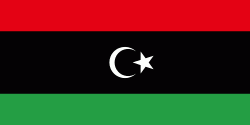Bani Walid (Bani Walid)
Bani Walid ( Anglicized: ; بني وليد, Libyan pronunciation: ) is a city in Libya located in the Misrata District. Prior to 2007, it was the capital of Sof-Aljeen District. Bani Walid has an airport. Under the Libyan Arab Jamahiriya, it was divided into two Basic People's Congresses: Dahra – Bani Walid (الظهرة – بني وليد), and Zaytouna – Bani Walid (الزيتونة – بني وليد).
It is the home to the Warfalla tribe, the only city in which only one tribe resides. A campus of Bani Walid University is located in Bani Walid.
In the 2011 Libyan Civil War, after the anti-Gaddafi forces captured Tripoli in August and Sabha in September, Bani Walid, along with Sirte, was one of two final strongholds held by forces loyal to the ousted government of Muammar Gaddafi. There were clashes between anti-Gaddafi forces surrounding the city and Gaddafi loyalists defending it throughout September and early October; the city was finally taken on 17 October.
Finnish company Perusyhtymä (today YIT) constructed in the 1980s a factory in the city used for the assembly of rifles and possibly other weapons. NATO reported that it had hit two "command hubs" in the city and one ammunition dump. It is possible that the latter had originally been built by Finns. 200 Finnish engineers and other experts worked in Bani Walid. Some had their families in the area. The "dirty jobs" were done by around 2,000 cheap labourers from the Philippines.
In Finland, the media found out the construction of the weapon factory in 1994 and 2011. In the 1980s, Libya was the second-largest country of export for the Finnish construction industry right after the Soviet Union. In the early 1980s Finns had about 20 major construction projects in Libya. In addition to the weapon factory, other Finnish constructions include streets in Tripoli and the entire oil city of Ras Lanuf. A large number of Libyan architects have been trained with Finnish help. Construction export became more difficult after the UN set up a trade embargo in 1992. As late as 2008, a shopping complex designed by Finns was being built.
It is the home to the Warfalla tribe, the only city in which only one tribe resides. A campus of Bani Walid University is located in Bani Walid.
In the 2011 Libyan Civil War, after the anti-Gaddafi forces captured Tripoli in August and Sabha in September, Bani Walid, along with Sirte, was one of two final strongholds held by forces loyal to the ousted government of Muammar Gaddafi. There were clashes between anti-Gaddafi forces surrounding the city and Gaddafi loyalists defending it throughout September and early October; the city was finally taken on 17 October.
Finnish company Perusyhtymä (today YIT) constructed in the 1980s a factory in the city used for the assembly of rifles and possibly other weapons. NATO reported that it had hit two "command hubs" in the city and one ammunition dump. It is possible that the latter had originally been built by Finns. 200 Finnish engineers and other experts worked in Bani Walid. Some had their families in the area. The "dirty jobs" were done by around 2,000 cheap labourers from the Philippines.
In Finland, the media found out the construction of the weapon factory in 1994 and 2011. In the 1980s, Libya was the second-largest country of export for the Finnish construction industry right after the Soviet Union. In the early 1980s Finns had about 20 major construction projects in Libya. In addition to the weapon factory, other Finnish constructions include streets in Tripoli and the entire oil city of Ras Lanuf. A large number of Libyan architects have been trained with Finnish help. Construction export became more difficult after the UN set up a trade embargo in 1992. As late as 2008, a shopping complex designed by Finns was being built.
Map - Bani Walid (Bani Walid)
Map
Country - Libya
 |
 |
| Flag of Libya | |
Libya has been inhabited by Berbers since the late Bronze Age as descendants from Iberomaurusian and Capsian cultures. In classical antiquity, the Phoenicians established city-states and trading posts in western Libya, while several Greek cities were established in the East. Parts of Libya were variously ruled by Carthaginians, Persians, and Greeks before the entire region becoming a part of the Roman Empire. Libya was an early center of Christianity. After the fall of the Western Roman Empire, the area of Libya was mostly occupied by the Vandals until the 7th century when invasions brought Islam to the region. In the 16th century, the Spanish Empire and the Knights of St John occupied Tripoli until Ottoman rule began in 1551. Libya was involved in the Barbary Wars of the 18th and 19th centuries. Ottoman rule continued until the Italo-Turkish War, which resulted in the Italian occupation of Libya and the establishment of two colonies, Italian Tripolitania and Italian Cyrenaica (1911–1934), later unified in the Italian Libya colony from 1934 to 1943.
Currency / Language
| ISO | Currency | Symbol | Significant figures |
|---|---|---|---|
| LYD | Libyan dinar | لد | 3 |
| ISO | Language |
|---|---|
| AR | Arabic language |
| EN | English language |
| IT | Italian language |















